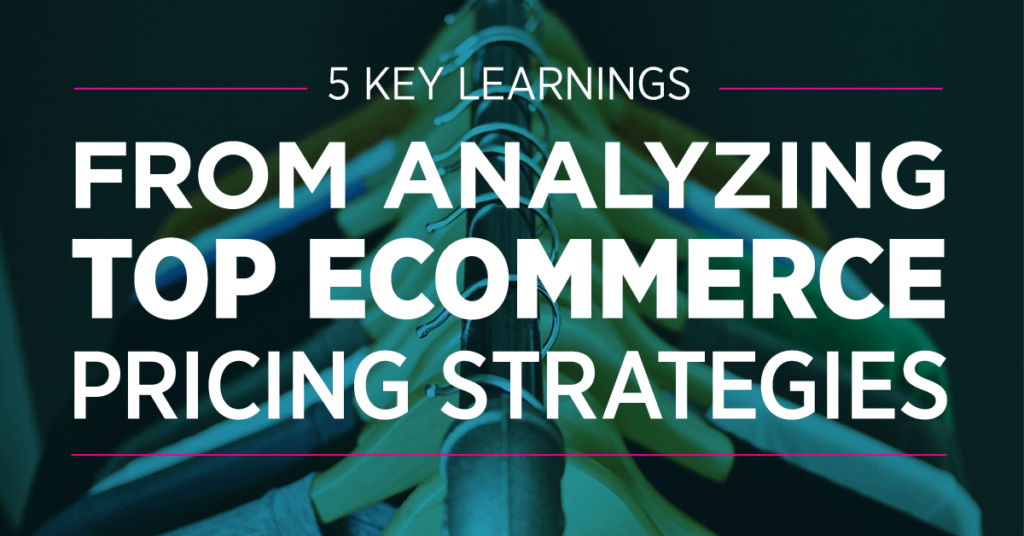When you’re starting an ecommerce business or putting new products in your store, one of the most important things you need to decide on is price. In ecommerce, the right pricing makes all the difference. You can create fantastic products that you know are better than anything else on the market and you can build a great store to sell those products, but if you can’t be strategic when it comes to pricing, you’ll never be able to build and scale a successful ecommerce business.
The problem with deciding on pricing is this: there’s really no single formula that will guarantee success. There are a lot of factors that all ultimately play a role in how you price your products. Your audience, your competitors, your unique selling proposition, your goals, your inventory—they all need to be considered when settling on the right pricing strategy for your individual products and your ecommerce store as a whole.
As someone who spends a lot of time writing about ecommerce and helping ecommerce businesses grow, I’m constantly digging into the most common and most effective pricing strategies being used by ecommerce brands today.
Here are 5 things I’ve learned that can help you develop an effective pricing strategy for your business:
Key Learning #1: Knowing Your Audience Matters Over Everything Else
Spending time identifying and getting to know your target audience is a crucial part of growing any type of business. For ecommerce, making time to understand your ideal customer is especially important because, unlike brick-and-mortar stores, you don’t usually have the benefit seeing or interacting with your customers and prospects face-to-face on a regular basis.
In ecommerce, you can’t sell products if you’re not able to connect with people who are willing, able, and interested in buying from you. In order to drive the right people to your website, you have to know how to reach them online.
So how do you do it? By defining your target audience.
The goal of defining your target audience is to understand:
- Who your customer is
- What motivates them
- Where they spend their time online
- What their pain points are
- What other products they buy
- Where they live
- How they prefer to interact with businesses
- What common objections they have
- How to communicate and engage with them
- What they care about and what they don’t care about
- How they choose and compare products
- How much they’re willing to spend on your products
- Any other information that can help you land on a price that ultimately motivates people to buy
There are a handful of fantastic resources that can help you define a target audience for your business and products. Here are three to start with:
- How to Identify Your Online Target Audience and Sell More by Peep Laja at ConversionXL
- How to Identify Your Target Market and Create Customer Personas by Katey Ferenzi at Bigcommerce
- How To Build Buyer Personas For Better Marketing by Richard Lazazzera at Shopify
As you’ll see when you go through the resources above, defining your audience usually involves making a few initial assumptions about who your customer is, then confirming or debunking those assumptions using a combination of both qualitative (conversations with customers and potential customers) and quantitative data (Google Analytics, demographic information, industry reports).
Once you have that information in hand, you can create your customer personas and use them as a resource when deciding how to price your products.
Key Learning #2: Psychology is Your Best Friend
Psychology plays a big role in ecommerce. It’s a hugely popular and widespread trend among ecommerce businesses for one main reason: it works. Each month there are hundreds of new blog posts and case studies being published online about different psychological and consumer behavior tactics you can use to convince people who land on your website to buy.
Here are a few articles I’ve found particularly valuable recently:
- 6 Psychological Triggers that Win Sales and Influence Customers by Mark Macdonald at Shopify
- How Understanding Psychology Can Help Increase Ecommerce Sales by Tereza Litsa at Search Engine Watch
- How to Sell More with eCommerce Psychology by Alex McEachern at Sweet Tooth Rewards
There are a number of psychological tactics you can implement as part of your pricing strategy. Here are three examples:
- Tactic #1: Comparison Pricing – The idea here is to list similar products next to each other in a comparison chart in order to drive more potential customers toward the product you want to sell most. The most well-known example of comparison pricing comes from how Apple sells their laptops, which Shopify dissects in detail in their blog post on psychology and pricing. Shopify also mentions a really interesting case study from Williams-Sonoma on comparison pricing, which was published in the New York Times (read it here).
- Tactic #2: The Power of 9’s –The idea here is to list a product for $19.99 rather than listing it for $20. It’s a pretty common tactic, but still incredibly effective according to researchers at MIT and the University of Chicago.
- Tactic #3: Shorter Syllables – The basic premise behind this tactic is that prices with shorter syllables will convert better than prices with long syllables. Pixel Union mentions a great study in a blog post on psychology and pricing in which researchers found that, “prices that have more syllables when spoken aloud are actually perceived as more expensive by consumers. If you take $17.89 or “seventeen-eighty-nine” and $18.12 or “eighteen-twelve,” the latter will convert better almost every time—never mind the fact that the former is actually the better deal (Source).” LemonStand also mentions this same tactic near the end of their blog post on ecommerce pricing strategy. Give it a read here.
For more ideas on how to use psychology to drive more sales, check out section #3 in this Sellbrite blog post on boosting product page conversions.
Key Learning #3: Experimentation is Essential
As I mentioned earlier, there’s not really one perfect pricing equation that works for every ecommerce business. In order to land on what works best for your business, you have to evaluate and test different types of pricing strategies.
Rather than going deep into every type of strategy available, I’d like to instead direct you to a fantastic resource that has already been written on the subject:
This blog post from Shopify outlines a variety of different pricing strategies you can consider using for your own ecommerce business. Their list includes:
- Keystone Pricing – listing products for double what you paid at wholesale.
- Manufacturer Suggested Retail Price (MSRP) – what the manufacturer recommends you sell the product for.
- Multiple Pricing – essentially bundling with other products or accessories and selling them for one price.
- Discount Pricing – creating special offers for specific seasons, inventory, and sales initiatives
- Loss-leading Pricing – Marking down a product to compete against competitors in order to get people to buy additional products in the process.
- Psychological Pricing – using specific psychological tactics to persuade people to buy.
- Based on Competition – setting prices either above or below what competitors are listing similar products for.
- Anchor Pricing – Showing the original pricing along with the discounted rate in order to show potential buyers the savings they would benefit from if they buy from you at the discounted rate.
The author of the Shopify blog post, Humayun Khan, goes into much more detail on each of the pricing strategies listed above, so I would definitely recommend spending some time going through it in its entirety.
It’s important to note that the pricing strategies mentioned above aren’t the only strategies out there. There are many more! LemonStand, for example, mentions a few more worth checking out in their blog post on ecommerce pricing, including dynamic pricing, market-oriented pricing, cost-based pricing, and consumer-oriented pricing.
Key Learning #4: Working Backwards Works
For some ecommerce business owners, the easiest way to figure out how to price products is to work backwards from the end-goal. In other words, if you’re not sure how to price your products, think about what your ultimate goals are , and then work backwards to determine how you need to price your products in order to meet those goals.
For example, are you trying to capture as much as the market as you can as fast as possible, or are you trying to make the most money that you can in the shortest amount of time? Your answer to this question will determine how you price your products. If you’re trying to capture the market from competitors, your strategy might be to price your products lower than your competitors. If you’re goal is to cover your costs and overhead and still come out ahead, then you might price your products more aggressively than competitors and invest more money into developing customer loyalty and referral programs and boosting brand recognition.
Following this technique will force you to think more about your bigger picture goals and help you zero in on what you want to ultimately achieve in the long run.
Key Learning #5: Branding and USP Are Hugely Important
The final ecommerce pricing learning that I want you to take away from this post is this: the brand reputation you create and the unique selling proposition (USP) you present to prospective buyers can greatly influence how much people are willing to spend for your products. If you’re selling the same product that 100 other companies are selling, it might not make much of a difference, but if you’re the market leader and you’ve got serious brand loyalty and recognition among your target audience, it definitely will.
So in summary, think about where your company is in comparison to other competitors in your space, think about the reputation you have among your customers and target audience, then price accordingly.
If you haven’t really focused on either of these areas before and you want to, start with these resources:
- To create a great brand for your ecommerce business, check out this guide from A Better Lemonade Stand.
- To create stronger USP’s, check out this helpful blog post from LemonStand.
How do you approach pricing at your ecommerce business? Tell me in the comments below!



1 thought on “5 Key Learnings From Analyzing Top Ecommerce Pricing Strategies”
As part of a team working on the Actonlytics eCommerce tool, I do this article be really useful for any person interested in eCommerce. I particularly liked the the Power of 9’s tactic.
Very good article!
Keep it up.
Comments are closed.